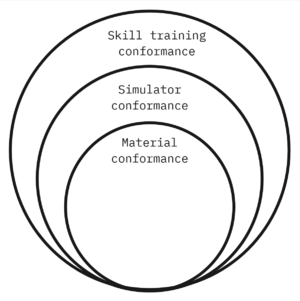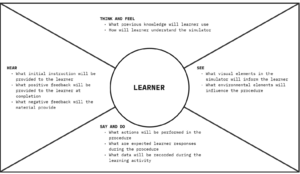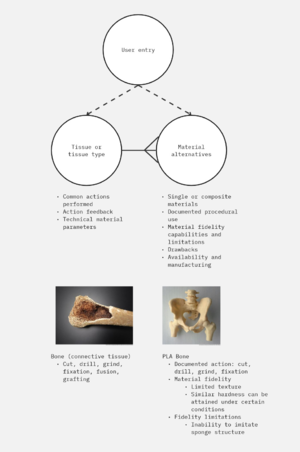
Definition of clinical conformance[edit | edit source]
This is the desired state of the clinical practice
- Procedure (real-life starting and ending states)
- Environmental conditions
- Available tools and equipment
Purpose and motivation[edit | edit source]
The main purpose of the materials database is to guarantee the appropriate fidelity of the simulators. Based on the concept of fitness of use,[1] the quality of a simulator material must comply with the following:
- Quality of design: Determine the intended characteristics to be simulated according to the tissue type.
- Quality of conformance: Fidelity of the material for the intended simulator.
- Availability: Facilitate the sourcing or preparation of materials to be used for simulators, including alternatives for hard-to-obtain materials.
- Field service: Outline the correct use, care, and replacement of materials.
Educational evidence conformance[edit | edit source]
Expected results from a skill training perspective:
- What should learners be able to identify?
- What actions should learners execute successfully?
- What actions should learners avoid?
Activity conformance[edit | edit source]

- Simulator and environmental conditions set up
- Expected simulator condition
- Tools
- Equipment
- Available materials
- Instructional method
| Action | Body tissue | Procedural outcome | Required fidelity type or means of verification
(visual/tactile/acoustic) |
Real-life positive feedback | Real-life negative feedback |
|---|---|---|---|---|---|
| Action 1 | |||||
| Action 2 | |||||
| Action 3 | |||||
| ... |
This leads to:
- Variable definition: physical (what you can see and touch) and functional (effects and changes)
- Prioritization of variables: In what which should variables be present in the system
Material selection[edit | edit source]

By tissue or structure[edit | edit source]
- Sub-tissues
- Documented material alternatives
- Examples in simulators
By material alternatives[edit | edit source]
- List of single or composite uses
- Used to simulate the following tissues or structures (list of tissues)
- Fidelity considerations
- Positive characteristics: how it resembles the tissue.
- Drawbacks and limitations: how does it fail to resemble the tissue for certain actions and ways to solve them.
- Feedback sources by action type
- Integrated: provided immediately by the material (e.g. it breaks)
- External: provided by an external system (e.g. instructor feedback, a separate electrical circuit, a different material).
- Availability: possible limitations in the procuring of the material.
- Manufacturing: required procedures to conform or condition the material.
- Specifications:
- Properties (mechanical, chemical)
- Standards
- etc.
- Examples in documented simulators
Considerations[edit | edit source]
- A material may have multiple names.
- Materials can be found in multiple configurations or variants (for example, cardboard can either be corrugated or recycled).
- Alternatives to materials should be provided if possible.
- All materials should point to examples of how they are used.
- Levels:
- Material category
- Level 1 (metals, non-metals, ceramics, composites
- Level 2 (ferrous, non-ferrous; thermoplastics, thermosets, elastomers; glasses, crystaline ceramics; metal matrix, ceramic matrix, polymer matrix)
Parameters[edit | edit source]
- General
- Simulated body tissue (e.g. skin, bone)
- Simulated body tissue type (e.g. epithelial, connective, muscle, nervous)
- Sourcing
- List of ingredients or parts
- Material providers
- Material or part standards (ASTM, ISO)
- Expected cost
- Quality requirements for sourced materials
- Preparation
- Fabrication requirements (e.g. 3D-printing, sewing, cutting)
- Conditioning requirements (e.g. hydrating, drying, curing, compression)
- Visual preparation (e.g. dying, texturizing)
- Require materials, tools or equipment for fabrication and conditioning (e.g. 3D-printer, saw, hand drill)
- Material manipulation hazards (e.g. material toxicity, abrasiveness)
- Quality assurance before use (e.g. visual, chemical, mechanical)
- Use
- Desired mechanical properties
- Desirable material feedback (e.g. visual, tactile)
- Displayed pathological features
- Manipulation hazards
Materials from SELF simulators[edit | edit source]
- PLA filament
- Cardboard
- Rubber bands
- Box cutter
- Plastic cling wrap
- Red felt
- Sponge
- White felt or clothe
- Small balloon
- Modeling balloon
- Red lipstick
- Gelatin
- Glycerine
- Food couloring
- Wool
- Vinyl exam gloves
- Sand
- Vessel loop
- Plastic wrap
- Silk ties
- Bamboo
- Clay
- Hand drill
- PVC
- PPR pipe
- Aluminium foil
- Drill bit
- Electric drill
- Play-dough
- Pipe insulation
- Foam sheets
- Silicone
- Cassava flou paste
- Liquid lattex
- Alligator clips
- Wood
- Screws
- Nut
- Nebulizer hose
- T tubes
- Pressure sensor
- LED traffic light module
- Voltage converter module
- Relay module
- Switch
- Polarized AC cable
- Pliers
- Hose
- Water pump
- Modelling balloon
- Plastic ties bag
- Wrenches
- Heat pipe
- Tongue depressors
- Cellophane
- Vise clamps
- Bed sheet
- Square foam blocks
- Hand gloves
- Circle printing pad
- Suture pad
- Smooth dissecting forceps
- Standar needle driver
- Felt
- Sand
- Vegetable oil
- Hole punch
- Liquid latex
- Weigh scale
- Kettle
- Toothbrush
- Mild detergent
- Nut
- Brass hose fitting adapter
- PVC plug
- Toothpicks
- Depth gauge
- Airtight Storage Container
- Resealable Bag
- Vise clamp
- Syringe
- Shallow container
- Cloth
- Stockings
- Cotton
- https://www.wikidata.org/wiki/Q8231603
- File:ALL-SAFE_Ectopic_Pregnancy_Simulation_11.6.pdf
References[edit | edit source]
- Austin, T., & Over, H. (2012). MatDB Online—A Standards-Based System for Preserving, Managing, and Exchanging Engineering Materials Test Data. Data Science Journal, 11, ASMD11–ASMD16. https://doi.org/10.2481/dsj.AMDS-003
- CWA-16200:2010.xml | NMRR. (n.d.). Retrieved November 27, 2023, from https://materials.registry.nist.gov/pid/rest/local/nmrr/UVZ8KFXS3OKSRKD68N70
- Dąbrowska, A. K., Rotaru, G.-M., Derler, S., Spano, F., Camenzind, M., Annaheim, S., Stämpfli, R., Schmid, M., & Rossi, R. M. (2016). Materials used to simulate physical properties of human skin. Skin Research and Technology: Official Journal of International Society for Bioengineering and the Skin (ISBS) [and] International Society for Digital Imaging of Skin (ISDIS) [and] International Society for Skin Imaging (ISSI), 22(1), 3–14. https://doi.org/10.1111/srt.12235
- Mahmud, J., & Azizzati, S. (2014). A Review on Synthetic Skin: Materials Investigation. Advanced Materials Research, Vol. 915-916, 858–866. https://doi.org/10.4028/www.scientific.net/AMR.915-916.858
- NMRR. (n.d.). Retrieved November 27, 2023, from https://materials.registry.nist.gov/
- Tanifuji, M., Matsuda, A., & Yoshikawa, H. (2019). Materials Data Platform—A FAIR System for Data-Driven Materials Science. 2019 8th International Congress on Advanced Applied Informatics (IIAI-AAI), 1021–1022. https://doi.org/10.1109/IIAI-AAI.2019.00206